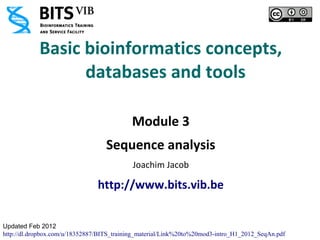This document outlines various concepts in sequence analysis within bioinformatics. It discusses tools and methodologies for analyzing DNA, RNA, and protein sequences, including prediction of biological functions, metrics for sequence properties, and the performance evaluation of prediction tools. Additionally, it emphasizes the importance of using reliable databases and tools for automatic annotation and feature prediction, alongside offering insights into specific analysis techniques like sequence alignment and motif detection.

















![Regular expressions / patterns are the
simplest way to represent motifs
A representation of all residues with equal probability.
123456 Position: 1. 2. 3. 4. 5. 6.
ATPKAE
KKPKAA [AKT] [AKLT] P [AK] [APT] [ADEKT-]
AKPKAK
TKPKPA
AKPKT-
AKPAAK ? Does this sequence match: AKPKTE
KLPKAD V V V V V V
AKPKAA
Consensus: AKPKAA ? And this sequence: KKPETE
V V V X V V
? And what about this one: TLPATE
For every position the most V V V V V V
Frequently occurring residue](https://image.slidesharecdn.com/mod3-introh12011seqan-110627023719-phpapp01/85/BITS-Basics-of-sequence-analysis-18-320.jpg)







-H-S-{P}-x(2)-P-x(2,4)-C>
You can retrieve sequences which correspond to a pattern,
you made up yourself, observed in an alignment or an
known one. The syntax is specific, but not difficult: see
link below!
http://prosite.expasy.org/scanprosite/scanprosite-doc.html#pattern_syntax](https://image.slidesharecdn.com/mod3-introh12011seqan-110627023719-phpapp01/85/BITS-Basics-of-sequence-analysis-26-320.jpg)



















![Sequence logos can give an insight in
the important residues of binding sites
DNA: an entry from JASPAR: tata box
A [ 61 16 352 3 354 268 360 222 155 56 83 82 82 68 77 ]
C [145 46 0 10 0 0 3 2 44 135 147 127 118 107 101 ]
G [152 18 2 2 5 0 10 44 157 150 128 128 128 139 140 ]
T [ 31 309 35 374 30 121 6 121 33 48 31 52 61 75 71 ]](https://image.slidesharecdn.com/mod3-introh12011seqan-110627023719-phpapp01/85/BITS-Basics-of-sequence-analysis-46-320.jpg)








